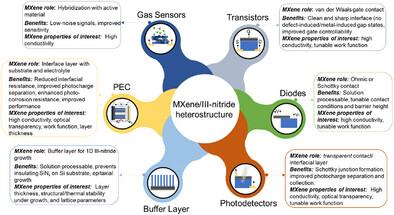MXene-Integrated III-Nitride Semiconductors: Recent Progress and Perspectives
IF 10
1区 物理与天体物理
Q1 OPTICS
引用次数: 0
Abstract
III-nitride semiconductors, including GaN, InN, and AlN, are widely recognized for their tunable direct bandgaps, high electron mobility, thermal and chemical stability, and large breakdown voltages, properties that enable a broad range of electronic and optoelectronic applications. However, the performance of III-nitride-based devices is limited by challenges in lattice matching, defect formation, and suboptimal contact interfaces. Recently, two-dimensional MXenes have emerged as promising materials to overcome these limitations due to their exceptional metallic conductivity, tunable work function, solution processability, and ability to form clean van der Waals interfaces. This review highlights recent advances in integrating MXenes with III-nitrides to improve device functionalities. Their roles as transparent electrodes, growth templates for nanostructures, and interfacial layers that suppress defect states and enhance charge transport, are discussed. Furthermore, the fundamental mechanisms underlying MXene/III-nitride heterostructures are analyzed, their applications across photodetectors, light-emitting diodes, power electronics, gas sensors, and photoelectrochemical water splitting are explored, and key challenges hindering commercial adoption are identified. Finally, future research directions are proposed to harness the full potential of MXene-III-nitride hybrid systems.

mxene集成iii -氮化物半导体:最新进展与展望
iii -氮化物半导体,包括GaN、InN和AlN,因其可调的直接带隙、高电子迁移率、热稳定性和化学稳定性以及大击穿电压而被广泛认可,这些特性使其能够广泛应用于电子和光电子领域。然而,基于iii -氮化物的器件的性能受到晶格匹配,缺陷形成和次优接触界面的挑战的限制。最近,二维MXenes由于其优异的金属导电性、可调谐的功功能、溶液可加工性以及形成干净的范德华界面的能力而成为克服这些限制的有前途的材料。本文重点介绍了将MXenes与iii -氮化物集成以改善器件功能的最新进展。讨论了它们作为透明电极、纳米结构生长模板以及抑制缺陷态和增强电荷输运的界面层的作用。此外,本文还分析了MXene/ iii -氮化物异质结构的基本机制,探讨了MXene/ iii -氮化物异质结构在光电探测器、发光二极管、电力电子、气体传感器和光电化学水分解等领域的应用,并指出了阻碍其商业化应用的主要挑战。最后,提出了未来的研究方向,以充分发挥mxene - iii -氮化物混合系统的潜力。
本文章由计算机程序翻译,如有差异,请以英文原文为准。
求助全文
约1分钟内获得全文
求助全文
来源期刊
CiteScore
14.20
自引率
5.50%
发文量
314
审稿时长
2 months
期刊介绍:
Laser & Photonics Reviews is a reputable journal that publishes high-quality Reviews, original Research Articles, and Perspectives in the field of photonics and optics. It covers both theoretical and experimental aspects, including recent groundbreaking research, specific advancements, and innovative applications.
As evidence of its impact and recognition, Laser & Photonics Reviews boasts a remarkable 2022 Impact Factor of 11.0, according to the Journal Citation Reports from Clarivate Analytics (2023). Moreover, it holds impressive rankings in the InCites Journal Citation Reports: in 2021, it was ranked 6th out of 101 in the field of Optics, 15th out of 161 in Applied Physics, and 12th out of 69 in Condensed Matter Physics.
The journal uses the ISSN numbers 1863-8880 for print and 1863-8899 for online publications.

 求助内容:
求助内容: 应助结果提醒方式:
应助结果提醒方式:


